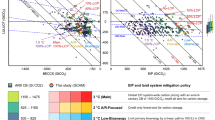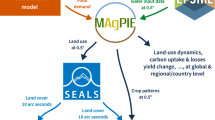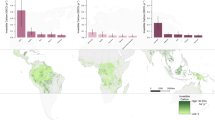Abstract
Carbon payments can help mitigate both climate change and biodiversity decline through the reforestation of agricultural land1. However, to achieve biodiversity co-benefits, carbon payments often require support from other policy mechanisms2 such as regulation3,4, targeting5,6, and complementary incentives7,8. We evaluated 14 policy mechanisms for supplying carbon and biodiversity co-benefits through reforestation of carbon plantings (CP) and environmental plantings (EP) in Australia’s 85.3 Mha agricultural land under global change. The reference policy—uniform payments (bidders are paid the same price) with land-use competition (both CP and EP eligible for payments), targeting carbon—achieved significant carbon sequestration but negligible biodiversity co-benefits. Land-use regulation (only EP eligible) and two additional incentives complementing the reference policy (biodiversity premium, carbon levy) increased biodiversity co-benefits, but mostly inefficiently. Discriminatory payments (bidders are paid their bid price) with land-use competition were efficient, and with multifunctional targeting of both carbon and biodiversity co-benefits increased the biodiversity co-benefits almost 100-fold. Our findings were robust to uncertainty in global outlook, and to key agricultural productivity and land-use adoption assumptions. The results suggest clear policy directions, but careful mechanism design will be key to realising these efficiencies in practice. Choices remain for society about the amount of carbon and biodiversity co-benefits desired, and the price it is prepared to pay for them.
This is a preview of subscription content, access via your institution
Access options
Subscribe to this journal
Receive 12 print issues and online access
$209.00 per year
only $17.42 per issue
Buy this article
- Purchase on Springer Link
- Instant access to full article PDF
Prices may be subject to local taxes which are calculated during checkout




Similar content being viewed by others
References
Lin, B. B., Macfadyen, S., Renwick, A. R., Cunningham, S. A. & Schellhorn, N. A. Maximizing the environmental benefits of carbon farming through ecosystem service delivery. BioScience 63, 793–803 (2013).
Bustamante, M. et al. Co-benefits, trade-offs, barriers and policies for greenhouse gas mitigation in the agriculture, forestry and other land use (AFOLU) sector. Glob. Change Biol. 20, 3270–3290 (2014).
Polglase, P. J. et al. Potential for forest carbon plantings to offset greenhouse emissions in Australia: Economics and constraints to implementation. Climatic Change 121, 161–175 (2013).
Renwick, A. R. et al. Biodiverse planting for carbon and biodiversity on indigenous land. PLoS ONE 9, e91281 (2014).
Thomas, C. D. et al. Reconciling biodiversity and carbon conservation. Ecol. Lett. 16, 39–47 (2013).
Wunscher, T. & Engel, S. International payments for biodiversity services: Review and evaluation of conservation targeting approaches. Biol. Conserv. 152, 222–230 (2012).
Bryan, B. A. et al. Supply of carbon sequestration and biodiversity services from Australia’s agricultural land under global change. Glob. Environ. Change 28, 166–181 (2014).
Crossman, N. D., Bryan, B. A. & Summers, D. M. Carbon payments and low-cost conservation. Conserv. Biol. 25, 835–845 (2011).
Kinzig, A. P. et al. Paying for ecosystem services-promise and peril. Science 334, 603–604 (2011).
Newell, R. G., Pizer, W. A. & Raimi, D. Carbon market lessons and global policy outlook. Science 343, 1316–1317 (2014).
Liu, J. G., Li, S. X., Ouyang, Z. Y., Tam, C. & Chen, X. D. Ecological and socioeconomic effects of China’s policies for ecosystem services. Proc. Natl Acad. Sci. USA 105, 9477–9482 (2008).
Daniels, A. E., Bagstad, K., Esposito, V., Moulaert, A. & Rodriguez, C. M. Understanding the impacts of Costa Rica’s PES: Are we asking the right questions? Ecol. Econ. 69, 2116–2126 (2010).
Busch, J. Supplementing REDD+ with biodiversity payments: The paradox of paying for multiple ecosystem services. Land Econ. 89, 655–675 (2013).
Venter, O. et al. Harnessing carbon payments to protect biodiversity. Science 326, 1368 (2009).
Ajayi, O. C., Jack, B. K. & Leimona, B. Auction design for the private provision of public goods in developing countries: Lessons from payments for environmental services in Malawi and Indonesia. World Dev. 40, 1213–1223 (2012).
Lindenmayer, D. B. et al. Avoiding bio-perversity from carbon sequestration solutions. Conserv. Lett. 5, 28–36 (2012).
Jack, B. K., Kousky, C. & Sims, K. R. E. Designing payments for ecosystem services: Lessons from previous experience with incentive-based mechanisms. Proc. Natl Acad. Sci. USA 105, 9465–9470 (2008).
Kenward, R. E. et al. Identifying governance strategies that effectively support ecosystem services, resource sustainability, and biodiversity. Proc. Natl Acad. Sci. USA 108, 5308–5312 (2011).
Wunder, S., Engel, S. & Pagiola, S. Taking stock: A comparative analysis of payments for environmental services programs in developed and developing countries. Ecol. Econ. 65, 834–852 (2008).
Polasky, S., Lewis, D. J., Plantinga, A. J. & Nelson, E. Implementing the optimal provision of ecosystem services. Proc. Natl Acad. Sci. USA 111, 6248–6253 (2014).
Nelson, E. et al. Efficiency of incentives to jointly increase carbon sequestration and species conservation on a landscape. Proc. Natl Acad. Sci. USA 105, 9471–9476 (2008).
Barry, L. E., Yao, R. T., Harrison, D. R., Paragahawewa, U. H. & Pannell, D. J. Enhancing ecosystem services through afforestation: How policy can help. Land Use Policy 39, 135–145 (2014).
Naeem, S. et al. Get the science right when paying for nature’s services. Science 347, 1206–1207 (2015).
Connor, J. D. et al. Modelling Australian land use competition and ecosystem services with food price feedbacks at high spatial resolution. Environ. Model. Software 69, 141–154 (2015).
Hatfield-Dodds, S. et al. CSIRO Australian National Outlook 2015 Technical Report (CSIRO, 2015); http://www.csiro.au/nationaloutlook
Galler, C., von Haaren, C. & Albert, C. Optimizing environmental measures for landscape multifunctionality: Effectiveness, efficiency and recommendations for agri-environmental programs. J. Environ. Manage. 151, 243–257 (2015).
Gao, L. et al. Robust global sensitivity analysis under deep uncertainty via scenario analysis. Environ. Model. Software (in the press).
Paquette, A. & Messier, C. The role of plantations in managing the world’s forests in the Anthropocene. Front. Ecol. Environ. 8, 27–34 (2010).
Menz, M. H. M., Dixon, K. W. & Hobbs, R. J. Hurdles and opportunities for landscape-scale restoration. Science 339, 526–527 (2013).
Wunder, S. When payments for environmental services will work for conservation. Conserv. Lett. 6, 230–237 (2013).
Securing a Clean Energy Future: The Australian Government’s Climate Change Plan (Department of Climate Change and Energy Efficiency, Commonwealth of Australia, 2011).
Hajkowicz, S. The evolution of Australia’s natural resource management programs: Towards improved targeting and evaluation of investments. Land Use Policy 26, 471–478 (2009).
Connor, J. D., Ward, J. R. & Bryan, B. Exploring the cost effectiveness of land conservation auctions and payment policies. Aust. J. Agric. Resour. Econ. 52, 303–319 (2008).
Higgins, V., Dibden, J. & Cocklin, C. Market instruments and the neoliberalisation of land management in rural Australia. Geoforum 43, 377–386 (2012).
van Vuuren, D. et al. The representative concentration pathways: An overview. Climatic Change 109, 5–31 (2011).
Newth, D., Cai, Y., Finnigan, J., Harman, I. & Grigg, N. The Shrinking Space for Climate Mitigation (CSIRO, 2015).
Nossal, K. & Sheng, Y. Productivity growth: Trends, drivers and opportunities for broadacre and dairy industries. Aust. Commodities 17, 216–230 (2010).
Dumortier, J. The effects of uncertainty under a cap-and-trade policy on afforestation in the United States. Environ. Res. Lett. 8, 044020 (2013).
Murray-Rust, D., Rieser, V., Robinson, D. T., Milicic, V. & Rounsevell, M. Agent-based modelling of land use dynamics and residential quality of life for future scenarios. Environ. Model. Software 46, 75–89 (2013).
Prestemon, J. P. & Wear, D. N. Linking harvest choices to timber supply. For. Sci. 46, 377–389 (2000).
Schroter, D. et al. Ecosystem service supply and vulnerability to global change in Europe. Science 310, 1333–1337 (2005).
Richards, K. R. & Stokes, C. A review of forest carbon sequestration cost studies: A dozen years of research. Climatic Change 63, 1–48 (2004).
van Rossum, G. The Python Community. The Python Programming Language Version 2.7.5 (The Python Software Foundation, 2013).
Jones, E., Oliphant, T., Peterson, P. & the SciPy Community SciPy: Open Source Scientific Tools for Python (2001); http://www.scipy.org
Harman, I. A Brief Guide to the Pattern Data within the ICP-ANO Process (CSIRO, 2013).
Polglase, P. et al. Regional Opportunities for Agroforestry Systems in Australia (Rural Industries Research and Development Corporation, 2008).
Ferrier, S., Manion, G., Elith, J. & Richardson, K. Using generalized dissimilarity modelling to analyse and predict patterns of beta diversity in regional biodiversity assessment. Divers. Distrib. 13, 252–264 (2007).
McInerney, D., Lempert, R. & Keller, K. What are robust strategies in the face of uncertain climate threshold responses? Robust climate strategies. Climatic Change 112, 547–568 (2012).
Smith, F. P. Assessing the habitat quality of oil mallees and other planted farmland vegetation with reference to natural woodland. Ecol. Manag. Restor. 10, 217–227 (2009).
Cunningham, S. C. et al. Balancing the environmental benefits of reforestation in agricultural regions. Perspect. Plant Ecol. Evol. Syst. 17, 301–317 (2015).
Bryan, B. A., Hajkowicz, S., Marvanek, S. & Young, M. D. Mapping economic returns to agriculture for informing environmental policy in the Murray-Darling Basin, Australia. Environ. Model. Assess. 14, 375–390 (2009).
Marinoni, O. et al. Development of a system to produce maps of agricultural profit on a continental scale: An example for Australia. Agric. Syst. 105, 33–45 (2012).
Bryan, B. A., King, D. & Ward, J. R. Modelling and mapping agricultural opportunity costs to guide landscape planning for natural resource management. Ecol. Indicators 11, 199–208 (2011).
Hajkowicz, S. & Young, M. Costing yield loss from acidity, sodicity and dryland salinity to Australian agriculture. Land Degrad. Dev. 16, 417–433 (2005).
Land Use of Australia Version 4, 2005–06 Dataset (Australian Bureau of Agricultural and Resource Economics, 2010).
Small Area of Agricultural Commodity Data 2005–06 (Australian Bureau of Statistics, 2006).
Burns, K., Hug, B., Lawson, K., Ahammad, H. & Zhang, K. Abatement Potential from Reforestation Under Selected Carbon Price Scenarios (Australian Bureau of Agricultural and Resource Economics and Sciences, 2011).
Bryan, B. A. & Crossman, N. D. Impact of multiple interacting financial incentives on land use change and the supply of ecosystem services. Ecosyst. Serv. 4, 60–72 (2013).
Paterson, S. E. & Bryan, B. A. Food-carbon trade-offs between agriculture and reforestation and the efficiency of market-based policies. Ecol. Soc. 17, 21 (2012).
Summers, D. M., Bryan, B. A., Nolan, M. & Hobbs, T. J. The costs of reforestation: A spatial model of the costs of establishing environmental and carbon plantings. Land Use Policy 44, 110–121 (2015).
van Dijk, A. I. J. M. & Renzullo, L. J. Water resource monitoring systems and the role of satellite observations. Hydrol. Earth Syst. Sci. 15, 39–55 (2011).
Acknowledgements
The authors are grateful to the Australian Research Council Centre of Excellence for Environmental Decisions and the National Environmental Research Program for funding two national workshops in which much of this paper was conceived. We are also grateful for the support of our individual organizations, especially CSIRO Agriculture and Australian National Outlook initiative.
Author information
Authors and Affiliations
Contributions
B.A.B., T.C., E.A.L., R.C. and K.A.W. conceived and designed the experiments, B.A.B. performed the experiments, all authors analysed the data, B.A.B. and M.N. contributed materials/analysis tools, and B.A.B., R.K.R., T.C., M.P.P., S.C.C., M.E.K., E.A.L., A.R.R., S.E., R.C. and K.A.W. wrote the paper.
Corresponding author
Ethics declarations
Competing interests
The authors declare no competing financial interests.
Supplementary information
Rights and permissions
About this article
Cite this article
Bryan, B., Runting, R., Capon, T. et al. Designer policy for carbon and biodiversity co-benefits under global change. Nature Clim Change 6, 301–305 (2016). https://doi.org/10.1038/nclimate2874
Received:
Accepted:
Published:
Issue Date:
DOI: https://doi.org/10.1038/nclimate2874
This article is cited by
-
Reducing environmental impacts through socioeconomic transitions: critical review and prospects
Frontiers of Environmental Science & Engineering (2023)
-
A bibliometric review of climate change cascading effects: past focus and future prospects
Environment, Development and Sustainability (2023)
-
Finding pathways to national-scale land-sector sustainability
Nature (2017)
-
Comparing groups versus individuals in decision making: a systematic review protocol
Environmental Evidence (2016)



